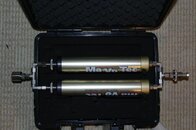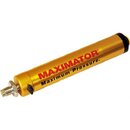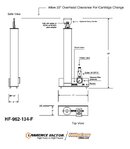You are using an out of date browser. It may not display this or other websites correctly.
You should upgrade or use an alternative browser.
You should upgrade or use an alternative browser.
Dew point of scuba air
- Thread starter BRT
- Start date
Please register or login
Welcome to ScubaBoard, the world's largest scuba diving community. Registration is not required to read the forums, but we encourage you to join. Joining has its benefits and enables you to participate in the discussions.
Benefits of registering include
- Ability to post and comment on topics and discussions.
- A Free photo gallery to share your dive photos with the world.
- You can make this box go away
So if you do everything right, how low of a dew point can you get using 13x for a dessicant? How do you do everything right?
Does this link help? https://airanalysis.com/Moisture_In_SCUBA___SCBA.html
and this: https://www.sorbentsystems.com/desiccants_charts.html
- Messages
- 245
- Reaction score
- 31
- # of dives
How do you do everything right ???
Why nobody took on that part I have no idea, but here you go.
Lots of debate on how you get there...but one fundamental across the board fact, dwell time.
The amount of time the air is in contact with the adsorbent. More time, more moisture is removed.
I can imagine, though have no way to prove that molecular sieve could if given time, get air very, very close to 0 ppm moisture content. It is tenacious in its desire to grab and hold water molecules. It has to be heated to 500* to get it to release the moisture it has trapped.
Slow the flow rate though the filters as is done in hyper filtration, to produce oxygen compatible air (Though this is more often then then not done to address micro particles of oil then water...flow rate is usually is controlled by a jewel with a laser drilled orifice that will allow a certain amount of air past at a given pressure.
Up size the existing filtration if there is any question of capacity and keep the filters pressurized at all times, even when not in use.
PMV. Pressure maintaining valve, to stop air from flowing through the filters at low pressure and high speed....(As in when you connect a near empty cylinder... set at as high a value as your system will allow, this will increase dwell time...is an absolute must have item..lack of one or its failure, and you will be pumping water and all manner of crap into your tanks in short order. I have pressure gauges before and after mine so I KNOW it is working. When it cracks open, the upside gauge drops and the downside gauge starts to rise. I fill direct to my tanks, and keep my filter pressure 190 BAR, normal is 140-150 BAR.
You will likely not be able to do this unless you are pumping into H.P. banks, but if you do as I do, you can get that high filter pressure..PMV located after the last filter, set to crack at about 250 bar,...with OPV at separator...set to open at about 270 Bar, thus keeping the filters at 180 bar (There is some slack in the PMV. (Usually around 50-70 BAR) Mine will first crack at about 250 BAR, then drop to its maintaining pressure, about 190 bar ...then at the whip manifold ANOTHER OPV set to 210 bar. This way you get high filter pressure, but no need to worry about over filling your 200 bar tanks.
Good M.S. and proper procedures can an you below -100*
Why nobody took on that part I have no idea, but here you go.
Lots of debate on how you get there...but one fundamental across the board fact, dwell time.
The amount of time the air is in contact with the adsorbent. More time, more moisture is removed.
I can imagine, though have no way to prove that molecular sieve could if given time, get air very, very close to 0 ppm moisture content. It is tenacious in its desire to grab and hold water molecules. It has to be heated to 500* to get it to release the moisture it has trapped.
Slow the flow rate though the filters as is done in hyper filtration, to produce oxygen compatible air (Though this is more often then then not done to address micro particles of oil then water...flow rate is usually is controlled by a jewel with a laser drilled orifice that will allow a certain amount of air past at a given pressure.
Up size the existing filtration if there is any question of capacity and keep the filters pressurized at all times, even when not in use.
PMV. Pressure maintaining valve, to stop air from flowing through the filters at low pressure and high speed....(As in when you connect a near empty cylinder... set at as high a value as your system will allow, this will increase dwell time...is an absolute must have item..lack of one or its failure, and you will be pumping water and all manner of crap into your tanks in short order. I have pressure gauges before and after mine so I KNOW it is working. When it cracks open, the upside gauge drops and the downside gauge starts to rise. I fill direct to my tanks, and keep my filter pressure 190 BAR, normal is 140-150 BAR.
You will likely not be able to do this unless you are pumping into H.P. banks, but if you do as I do, you can get that high filter pressure..PMV located after the last filter, set to crack at about 250 bar,...with OPV at separator...set to open at about 270 Bar, thus keeping the filters at 180 bar (There is some slack in the PMV. (Usually around 50-70 BAR) Mine will first crack at about 250 BAR, then drop to its maintaining pressure, about 190 bar ...then at the whip manifold ANOTHER OPV set to 210 bar. This way you get high filter pressure, but no need to worry about over filling your 200 bar tanks.
Good M.S. and proper procedures can an you below -100*
Does this link help? https://airanalysis.com/Moisture_In_SCUBA___SCBA.html
and this: https://www.sorbentsystems.com/desiccants_charts.html
I had found those. Unfortunately they don't tell me much except that at high pressures and low temperatures a -65 dew point is not low enough to keep water from condensing. That doesn't tell me what I need to do to get the dew point to -85 or below so at 3500psi and 12 degrees I will not get condensation. I don't dive much in 12 degree water because the chainsaw won't start, but I do travel in low temperatures.
- Messages
- 245
- Reaction score
- 31
- # of dives
Your answer is above.
How do you do everything right ???
Why nobody took on that part I have no idea, but here you go.
Lots of debate on how you get there...but one fundamental across the board fact, dwell time.
The amount of time the air is in contact with the adsorbent. More time, more moisture is removed.
I can imagine, though have no way to prove that molecular sieve could if given time, get air very, very close to 0 ppm moisture content. It is tenacious in its desire to grab and hold water molecules. It has to be heated to 500* to get it to release the moisture it has trapped.
Slow the flow rate though the filters as is done in hyperfiltration, to produce oxygen compatible air (Though this is more often then then not done to address micro particles of oil then water...flow rate is usually is controlled by a jewel with a laser drilled orifice that will allow a certain amount of air past at a given pressure.
Up size the existing filtration if there is any question of capacity and keep the filters pressurized at all times, even when not in use.
PMV. Pressure maintaining valve, to stop air from flowing through the filters at low pressure and high speed....(As in when you connect a near empty cylinder... set at as high a value as your system will allow, this will increase dwell time...is an absolute must have item..lack of one or its failure, and you will be pumping water and all manner of crap into your tanks in short order. I have pressure gauges before and after mine so I KNOW it is working. When it cracks open, the upside gauge drops and the downside gauge starts to rise. I fill direct to my tanks, and keep my filter pressure 190 BAR, normal is 140-150 BAR.
You will likely not be able to do this unless you are pumping into H.P. banks, but if you do as I do, you can get that high pressure..PMV located after the last filter...with OPV at separator...set to open at about 250 Bar, thus keeping the filters at 180 bar (There is some slack in the PMV. it will first crack at about 250 BAR, then drop to its maintaining pressure, Usually around 50-70 BAR less ...then at the whip manifold ANOTHER OPV set to 210 bar. This way you get high filter pressure, but no need to worry about over filling your 200 bar tanks.
Thanks for the reply. I have a 1900 psi working priority valve. It holds right there as it cracks. Running numbers through this calculator Dew Point Calculator | Howell Laboratories I don't see a big gain going from 1900 to 2700 psi unless the 13x multiplies the effect of the raised pressure dew point. In other words the 3500 psi dew point doesn't drop that much by raising the pressure from 1900 to 2700 psi, unless the 13x works way better at the 2700 psi level and I can't find any charts or calculators that tell me that. My compressor is painfully slow, about 1.9 cfm, so under no circumstances do I blow a lot of air by the filter. What I do do is travel with filled nitrox tanks in cold weather and get little rust spots. There is the possibility that these come from fills at shops but I want to make sure my fills are not causing the problem.
- Messages
- 245
- Reaction score
- 31
- # of dives
PMV pressure will increase the efficiency of the filter you have...If you are testing your air and coming up with high numbers, despite the small pump..you likely need more filtration or more dwell time..if you are rusting from your own fills, AND you are testing high for moisture assuming all other stuff is okay...you are pumping too fast for the filtration you have.
Most hyper filters designed for moderate flow...6-12 cfm, then the prices are just nuts.
I have not seen the Howell labs documents, despite a few errors and omissions..the 'Compressor filter lifetime calculator from scubaenginner.com will clearly show you you the effect of increased filter and separator pressure...
https://www.dropbox.com/s/xq6u07wwsz12sgt/compressor_filter_lifetime_calculator.xls?dl=0
Plug in the numbers. it has proven EXTREMELY accurate for me as I have played with all of the variables over the last 5 years and measurement bears out the theory. There is a place for PMV pressure in the calculations.
The only way to be sure it is not you, is test your air..a few little flash type rust spots are inconsequential. Most dive shops fail air tests on moisture and you are diving cold...likely it is their shop air that is getting you..if so, a small portable hyper filer between their whip and your tank will stop this problem. I DO NOT mean that stupid coltri "Personal filter".
Most hyper filters designed for moderate flow...6-12 cfm, then the prices are just nuts.
I have not seen the Howell labs documents, despite a few errors and omissions..the 'Compressor filter lifetime calculator from scubaenginner.com will clearly show you you the effect of increased filter and separator pressure...
https://www.dropbox.com/s/xq6u07wwsz12sgt/compressor_filter_lifetime_calculator.xls?dl=0
Plug in the numbers. it has proven EXTREMELY accurate for me as I have played with all of the variables over the last 5 years and measurement bears out the theory. There is a place for PMV pressure in the calculations.
The only way to be sure it is not you, is test your air..a few little flash type rust spots are inconsequential. Most dive shops fail air tests on moisture and you are diving cold...likely it is their shop air that is getting you..if so, a small portable hyper filer between their whip and your tank will stop this problem. I DO NOT mean that stupid coltri "Personal filter".
Last edited:
- Messages
- 245
- Reaction score
- 31
- # of dives
something for real, like this...but put a pmv on it as well as a micronic filter. Have them fill it slow, about a 20 miniute fill, 6 cfm or so.

This one is cheaper and smaller and includes the no return valve...
MaVoTec Nitrox-Clean Filter - DiveSupport GmbH
Or do it for real


This one is cheaper and smaller and includes the no return valve...
MaVoTec Nitrox-Clean Filter - DiveSupport GmbH

Or do it for real

Last edited:
Similar threads
- Replies
- 0
- Views
- 365
- Replies
- 15
- Views
- 1,066
- Replies
- 0
- Views
- 349
- Replies
- 0
- Views
- 150




